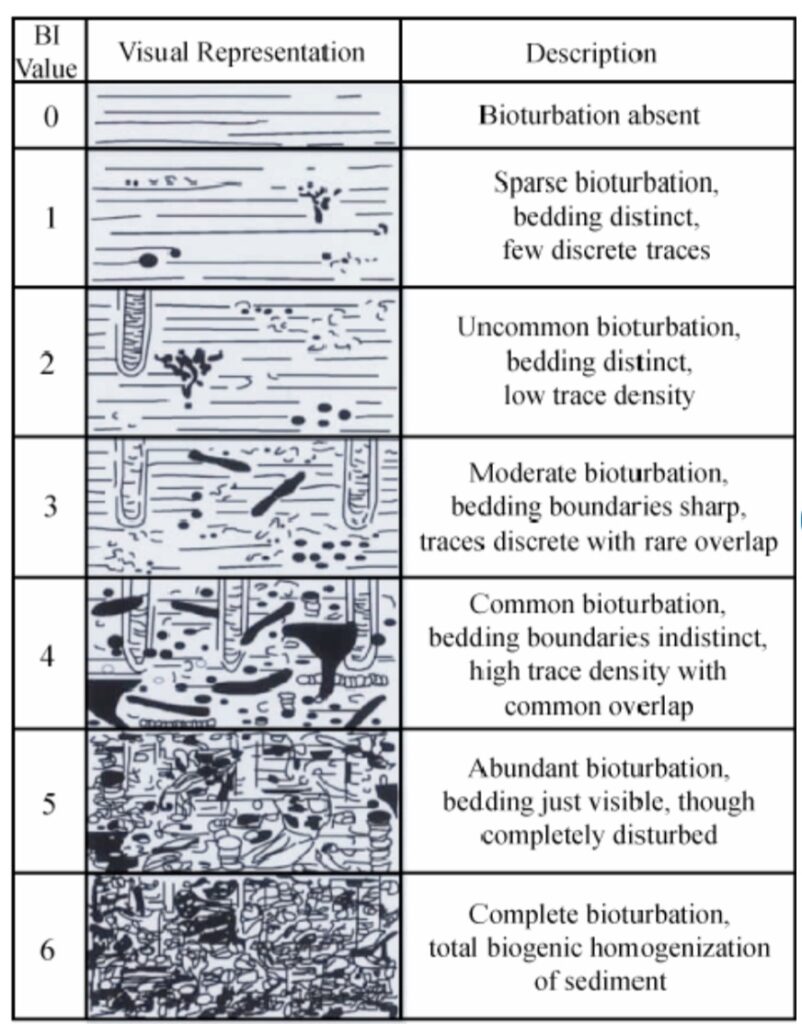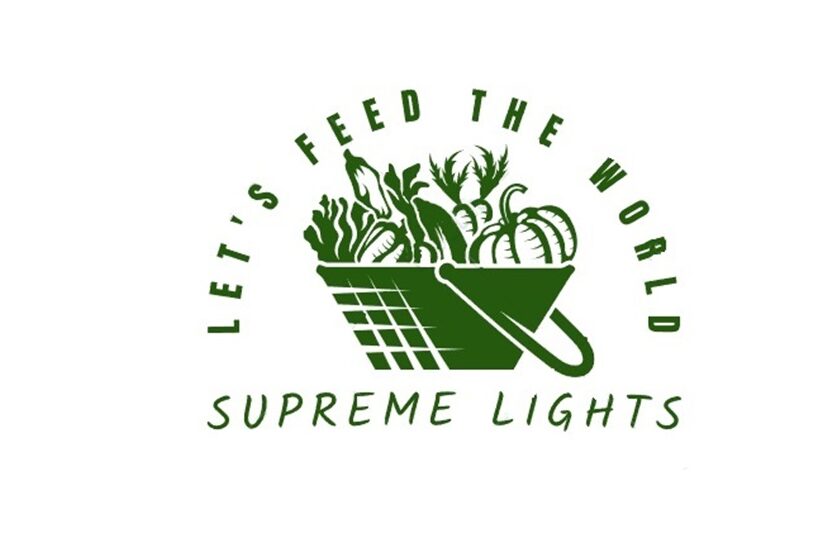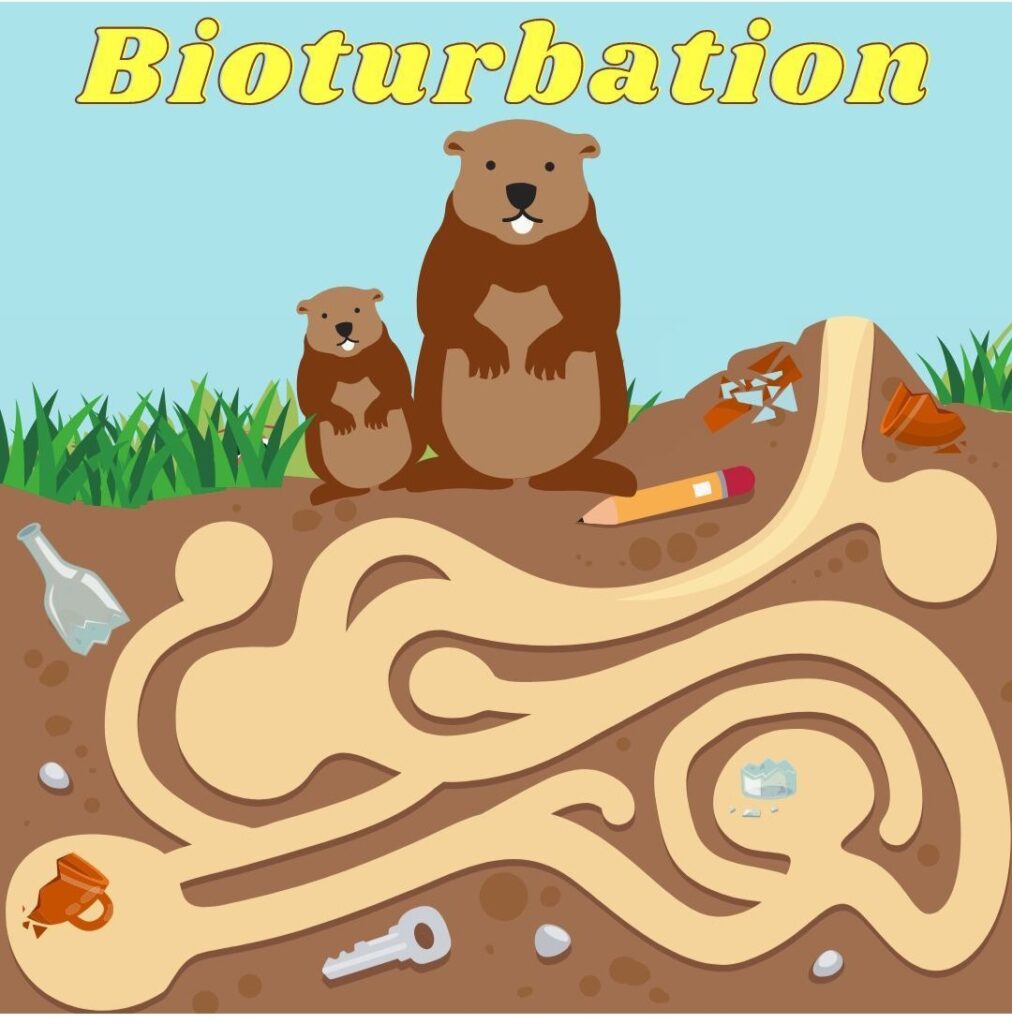
Bioturbation is the process by which plants and animals move, mix, and restructure soil and sediment. It can simply be defined as the mixing of soil or sediments by living organisms. It can occur in terrestrial or aquatic habitat.
Charles Darwin was the first person to recognize the importance of bioturbation for soil processes and geomorphology. He devoted his final scientific book to the subject.
Bioturbation is one of the agents of organic weathering. It includes burrowing, ingestion, and defecation of sediment grains by organisms. It also include displacing soil by plant roots, digging by burrowing animals (such as ants or rodents), pushing sediment aside (such as in animal tracks), or eating and excreting sediment, as earthworms do. Bioturbation aids the penetration of air and water and loosens sediment to promote winnowing or washing (transportation). It is important for the environment and is considered a primary driver of biodiversity.
The primary goal of bioturbation is for organisms to access resources in soil such as food, plant nutrients and water.
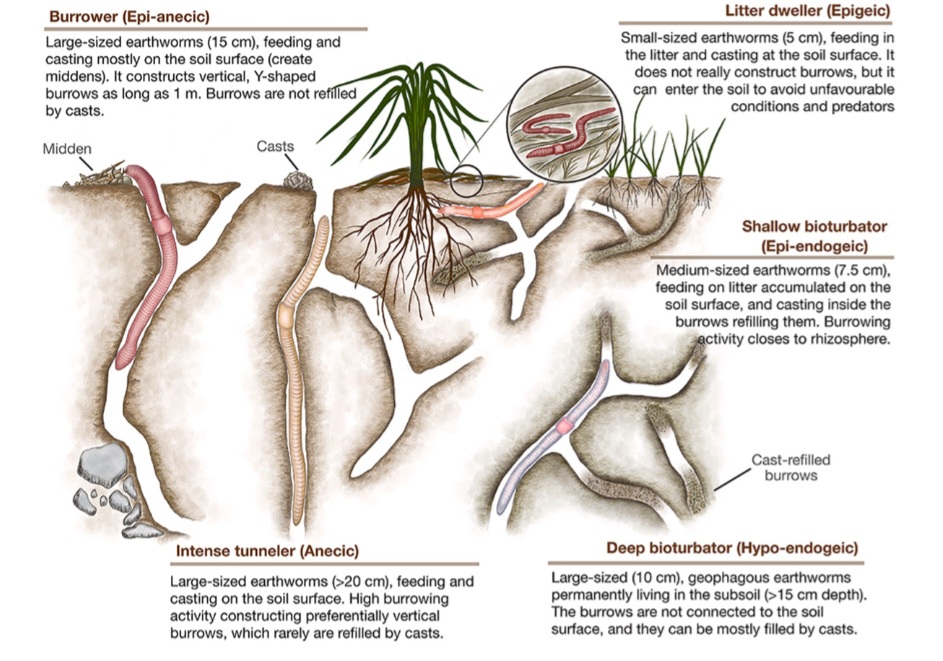
Bioturbation includes soil translocation by burrowing and ingestion, soil deformation by organism expansion, and soil stabilization by compounds secreted by organisms and their tissue. It also involves the transport of solutes and solids by the activities (e.g., feeding and movement) of macrobenthos. These macrobenthos include arthropods, annelids, and mollusks, which live in biogenic structures buried in the sediment. These processes are extremely important to the formation of soil structure, with impacts to flow and transport properties. Damage to soils from intensive management, compaction or carbon depletion limits the capacity for bioturbation, but bioturbation also helps to restore degraded soils.
A BRIEF DESCRIPTION OF BIOTURBATION PROCESS
When animals burrow into sediments, they turn the sediments.
In modern environments, bioturbation destroys almost all bedding in the sediments. Rocks are usually layered into sediments. As animals act on the rock, they take time to destroy the rock layers for bioturbation to occur. For example, this simple illustration will give a clearer picture of how Bioturbation occur. When fresh slices of bread are placed on each other and left, the layers of sliced bread remains fresh without damage. But if the layers of slice bread are left for a week, a lot of damages will occur as mould will grow on it, rats and insects will feed on it etc damaging the bread. Addition of fresh slices of bread on top to the damaged layers of fresh bread will result to further spread of damage to the upper layers. This relate to how bioturbation occurs in rock layers. The effect of bioturbation can only be noticed after some time like a thousand years.
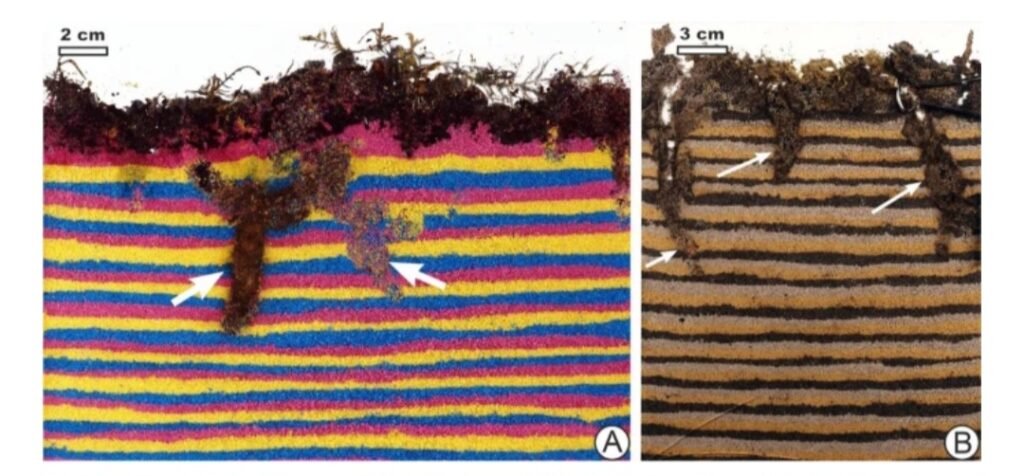
STEPS IN PRESERVING A DISTINCT SEDIMENTS LAYERS
1.Deposit the layer over a wide area of mud
2. Quick covering of the layers to protect it from erosion and bioturbation ( animal burrow or burrows animals dug in sediments).
3. Cementing agents
ORGANISMS THAT CAUSES BIOTURBATION
Organisms that causes bioturbation are called Bioturbators. They are organisms that live in soft sediment habitats and modify sediments. Through their activities, such as feeding and movement, result in burrows, mounds, and feeding or crawling traces. The type of trace left behind after their activities can help identify the types of bioturbators in an area.
For examples:
a. CHIRONOMIDS: Dig and ventilate semipermanent U-shaped tubes
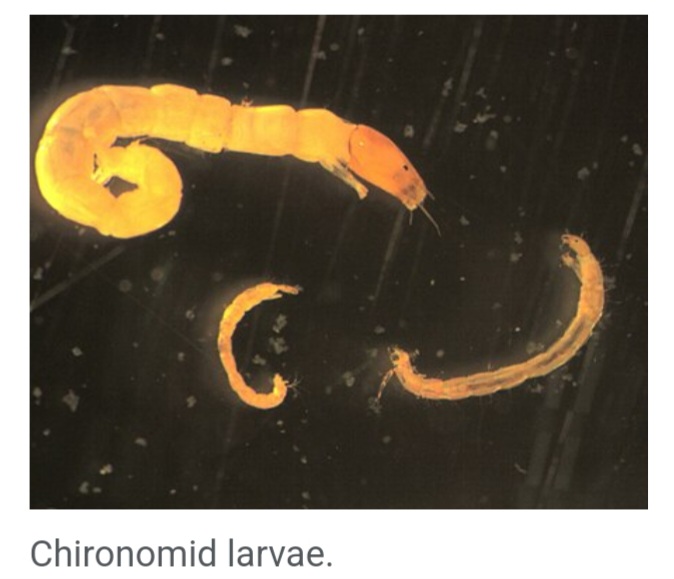
b. TUBIFICID OLIGOCHETES: Live upside down and feed on bottom sediment
c. BIVALVES: Burrow into sediments with only their siphon linked to the surface.
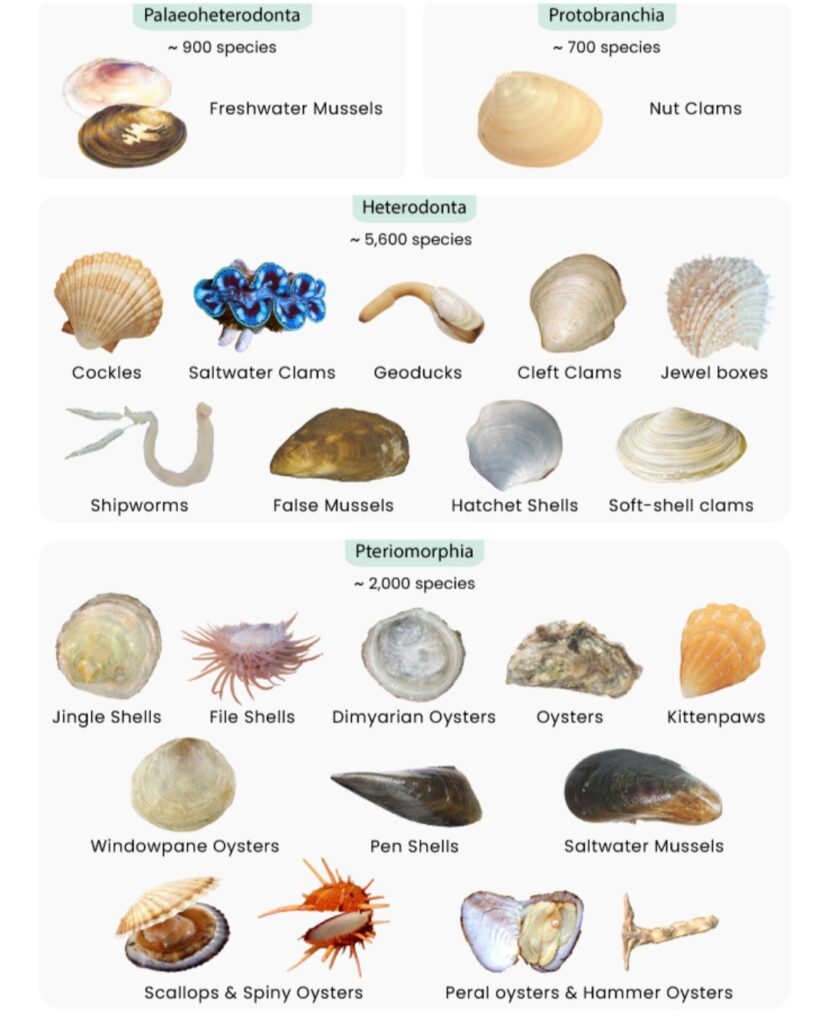
Several organisms are involved in the process of bioturbation. The two major sources of bioturbation are: Burrowing animals and the actions of plant roots. The other organisms include : crustaceans, annelid worms (polychaetes, oligochaetes, etc.), gastropods, bivalves, holothurians, fish, and many other infaunal and epifaunal organisms. They range from aquatic to terrestrial organisms. Some of the aquatic organisms include:
Walruses, salmon, carps, and pocket gophers are examples of large bioturbators in the aquatic environment. Although the activities of these large macrofaunal bioturbators are more conspicuous, the dominant bioturbators are small invertebrates, such as earthworms, polychaetes, ghost shrimp, mud shrimp, and midge larvae. The activities of these small invertebrates, which include burrowing and ingestion and defecation of sediment grains, contribute to mixing and the alteration of sediment structure.
In the terrestrial environment, examples of bioturbators include: Earthworms, collembolans, ants, burrowing clams, burrowing rats, mice, rabbits, beetles, and plant roots etc.
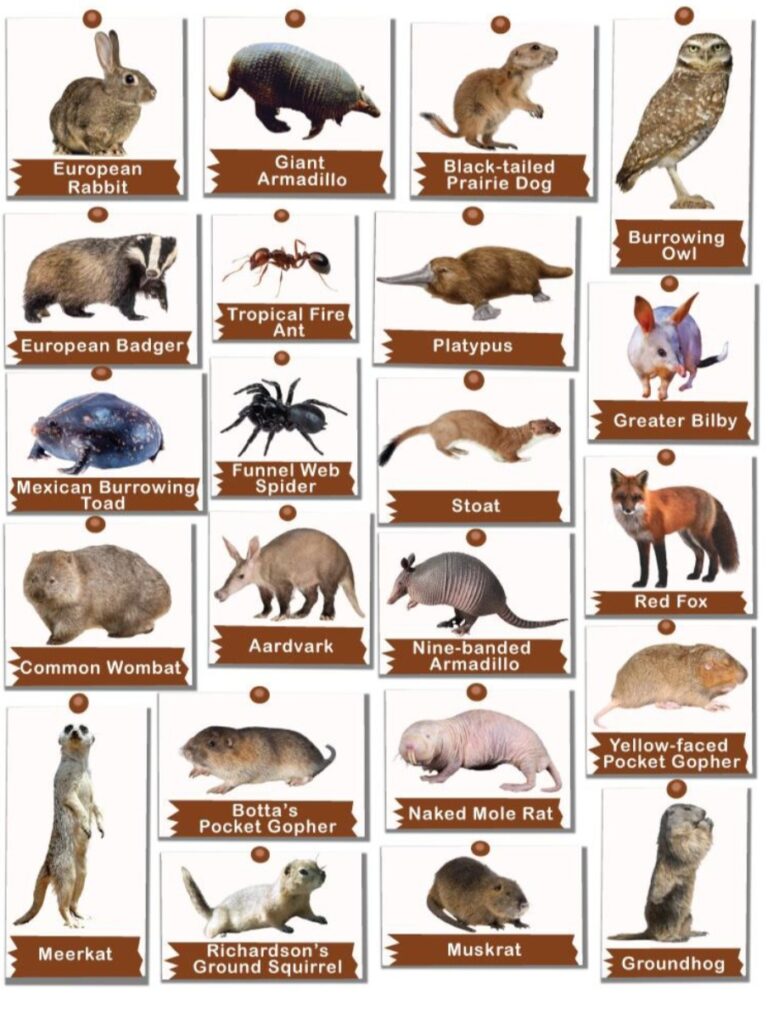
CLASSIFICATION OF BIOTURBATORS BASED ON THEIR FUNCTIONAL GROUPS
Bioturbators have been organized into variety of functional groupings based on the following:
a. SEDIMENT TRANSPORT: The most common classification is based on how bioturbators move and interact with sediments. They transport sediment particles and pore water through burrowing, deposit feeding, and other activities during the process of bioturbation. Their activities significantly impact the physical and chemical properties of sediment.
b. ECOLOGICAL CHARACTERISTICS: Bioturbators can be grouped based on ecological characteristics.
c. Biogeochemical effects: Biogeochemical effects are the effects of biotic and abiotic factors on the movement of nutrients and other elements. Therefore, Bioturbators can be grouped based on biogeochemical effects.
d. FEEDING AND MOTILITY: Bioturbators can be grouped based on feeding and motility.
e. FEEDING AND BIOLOGICAL INTERACTIONS: Bioturbators can be grouped based on feeding and biological interactions.
f. MOBILITY MODES: Bioturbators can be grouped based on mobility.
All of these groupings are based on the way bioturbators transport and interact with sediments, and their function.
CATEGORIES OF BIOTURBATORS
There are five categories of bioturbators. They include:
1. GALLERY-DIFFUSERS : They create complex tube networks within the upper sediment layers and transport sediment through feeding, burrow construction, and general movement throughout their galleries. Gallery-diffusers are heavily associated with burrowing polychaetes, such as Nereis diversicolor , bivalves like N. virens, which excavates burrows and Marenzelleria spp.
2. BIODIFFUSERS: They transport sediment particles randomly over short distances as they move through sediments. The biodiffusers moves particles and particulate organic matter found near sediment surface. Animals mostly attributed to this category include bivalves such as clams, amphipod species, M. balthica and Mya arenaria, etc but can also include larger vertebrates, such as bottom-dwelling fish and rays that feed along the sea floor. Biodiffusers can be further divided into two subgroups, which include:
epifaunal (organisms that live on the surface sediments) biodiffusers and surface biodiffusers: This subgrouping may also include gallery-diffusers.
3. UPWARD-CONVEYORS: These are bioturbators oriented head-down in sediments. Their feeding takes place at depth and transport sediment through their guts to the sediment surface. Major upward-conveyor groups include burrowing polychaetes like the lugworm, Arenicola marina, and thalassinid shrimps.
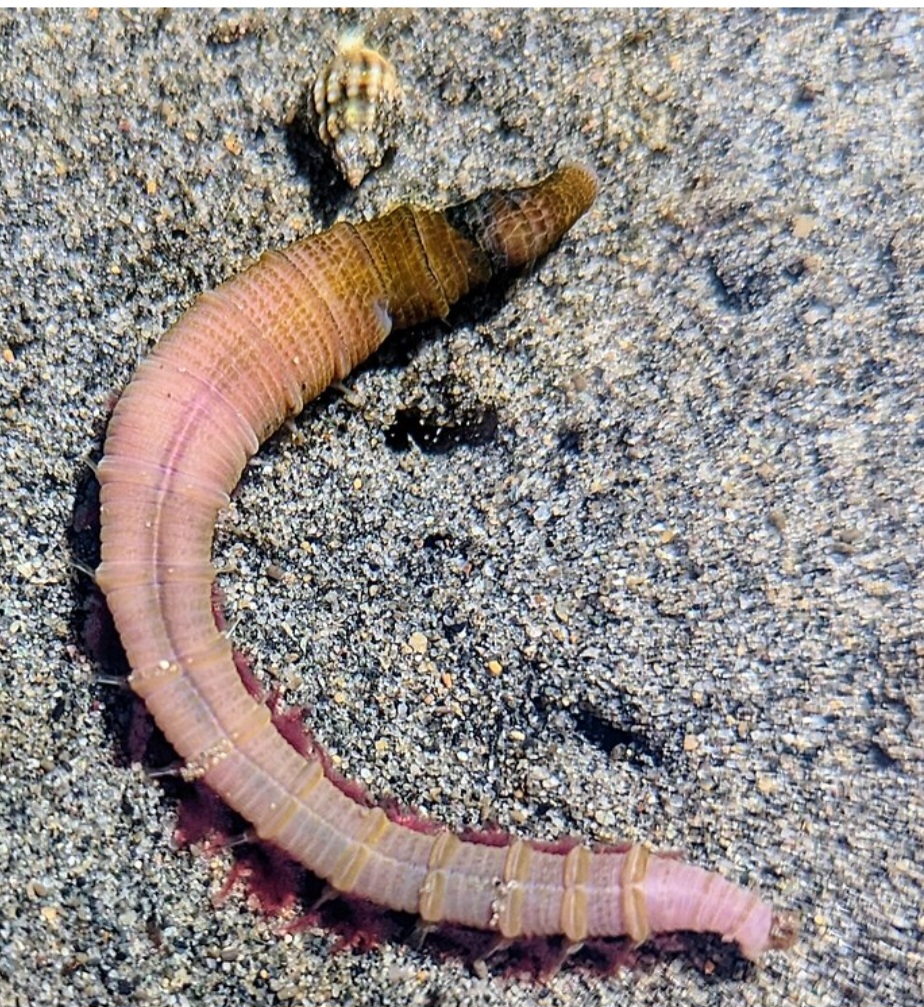
4. DOWNWARD-CONVEYOR SPECIES: These are bioturbators oriented with their heads towards the sediment-water interface. They defecate at depth. Their activities transport sediment from the surface to deeper sediment layers as they feed. Notable downward-conveyors include those in the peanut worm family, Sipunculidae.
5. REGENERATORS: They are categorized by their ability to release sediment to the overlying water column, which is then dispersed as they burrow. After regenerators abandon their burrows, water flow at the sediment surface and can push in and collapse the burrow. Examples of regenerator species include fiddler and ghost crabs.
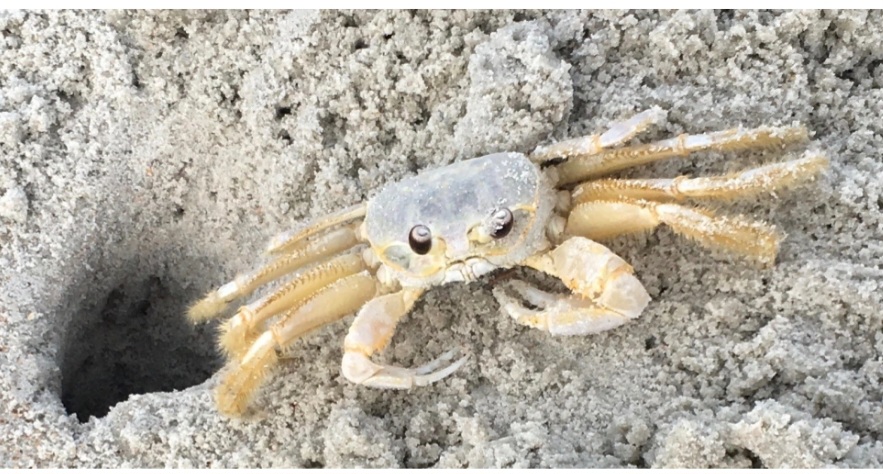
HOW BIOTURBATION WORK
Rocks are consolidated soid materials from which soils are formed. These rocks and soils are made up of so many distinct layers.
Under ideal circumstances, sedimentary rock is formed. Sedimentary rocks can be formed from pre-existing rocks, pieces of organisms, or chemical precipitates. The sediments which include bits of soil, rock, and organic matter, collect on the surface of the land or at the bottom of rivers and oceans are compressed together over time to a point of which they form rock. This process is called lithification. They are often found in layers, or bedding, which can be used to create a relative timeline of when the layers were deposited.
The older layers of the sedimentary rocks do lie under newer layers. The older layers of the rock can be forced to the surface by various factors such as volcanoes, and biological processes such as activities of organisms, plant roots etc.
Organisms and plants are constantly shifting and changing Earth’s sediments.
Since bioturbation is so common, sedimentary rocks are divided into three groups that describe their level of bioturbation:
Burrowed rocks, laminated rocks and massive rocks.
a. Burrowed rock is filled with evidence of organisms, and may contain elements from several different sedimentary layers.
b. Laminated rock shows evidence of bioturbation at the surface caused by non-burrowing activity. Examples include furrows and tracks created by aquatic or terrestrial animals.
c. The massive rock contains sediments from just a single layer.
EXAMPLES OF BIOTURBATION
Bioturbation occurs in many different environments and at several different levels. For example:
a. Earthworms digging through soil can shift older materials to higher layers. They can also leave behind traces of their activity in the form of fecal matter which, over time, lithifies.
b. Burrowing marine animals such as crabs, clams, and shrimp, can radically change sedimentary layers. These animals burrow into the sand, creating tunnels and moving materials from one sedimentary layer to another. If the tunnels are sturdy enough, they may later be filled with material formed at a later time.
c. Tree roots often run through multiple layers of soil. As they grow, they may disturb or mix sediments. When they fall, they pull older materials to the surface.
SIGNIFICANCE OF BIOTURBATION
1. Bioturbation provides researchers with information about sediments, and thus about the geology and history of the sediments and the area. For example:
Bioturbation can suggest that a particular area is likely to be rich in petroleum or other natural resources;
2. Bioturbation can provide clues to ancient life in the form of fossilized animal and plant remains;
3. Bioturbation can provide information about life cycles, dietary habits, and migration patterns of contemporary organisms.
4. Bioturbation processes brings water and oxygen into the sediments.
5. The disruption of aquatic sediments and terrestrial soils through bioturbating activities provides significant ecosystem services. These include
a. the alteration of nutrients in aquatic sediment and overlying water,
b. shelter to other species in the form of burrows in terrestrial and water ecosystems, and soil production on land.
6. Bioturbators can also inhibit the presence of other benthic organisms by smothering, exposing other organisms to predators, or resource competition.
7. Bioturbators like thalassinidean shrimps can provide shelter for some organisms and cultivate interspecies relationships within burrows, they have also been shown to have strong negative effects on other species, especially those of bivalves and surface-grazing gastropods, because thalassinidean shrimps can smother bivalves when they resuspend sediment. They have also been shown to exclude or inhibit polychaetes, cumaceans, and amphipods. This has become a serious issue in the northwestern United States, as ghost and mud shrimp (thalassinidean shrimp) are considered pests to bivalve aquaculture operations.
8. The presence of bioturbators can have both negative and positive effects on the recruitment of larvae of conspecifics (those of the same species) and those of other species, as the resuspension of sediments and alteration of flow at the sediment-water interface can affect the ability of larvae to burrow and remain in sediments. This effect is largely species-specific, as species differences in resuspension and burrowing modes have variable effects on fluid dynamics at the sediment-water interface. Deposit-feeding bioturbators may also hamper recruitment by consuming recently settled larvae.
9. Since its onset around 539 million years ago, bioturbation has been responsible for changes in ocean chemistry, primarily through nutrient cycling. Bioturbators played, and continue to play, an important role in nutrient transport across sediments. For example, bioturbating animals are hypothesized to have affected the cycling of sulfur in the early oceans. According to this hypothesis, bioturbating activities had a large effect on the sulfate concentration in the ocean.
10. Bioturbators have also altered phosphorus cycling on geologic scales. Bioturbators mix readily available particulate organic phosphorus (P) deeper into ocean sediment layers which prevents the precipitation of phosphorus (mineralization) by increasing the sequestration of phosphorus above normal chemical rates. The sequestration of phosphorus limits oxygen concentrations by decreasing production on a geologic time scale. This decrease in production results in an overall decrease in oxygen levels, and it has been proposed that the rise of bioturbation corresponds to a decrease in oxygen levels of that time. The negative feedback of animals sequestering phosphorus in the sediments and subsequently reducing oxygen concentrations in the environment limits the intensity of bioturbation in this early environment.
11. Organic contaminants: Bioturbation can either enhance or reduce the flux of contaminants from the sediment to the water column, depending on the mechanism of sediment transport. In polluted sediments, bioturbating animals can mix the surface layer and cause the release of sequestered contaminants into the water column. Upward-conveyor species, like polychaete worms, are efficient at moving contaminated particles to the surface. Invasive animals can remobilize contaminants previously considered to be buried at a safe depth. In the Baltic Sea, the invasive Marenzelleria species of polychaete worms can burrow to 35-50 centimeters which is deeper than native animals, thereby releasing previously sequestered contaminants. However, bioturbating animals that live in the sediment (infauna) can also reduce the flux of contaminants to the water column by burying hydrophobic organic contaminants into the sediment. Burial of uncontaminated particles by bioturbating organisms provides more absorptive surfaces to sequester chemical pollutants in the sediments.
12. Nutrient cycling is still affected by bioturbation in the modern Earth. Some examples in the terrestrial and aquatic ecosystems are below.
13. In the Terrestrial habitat, plants and animals utilize soil for food and shelter, disturbing the upper soil layers and transporting chemically weathered rock called saprolite from the lower soil depths to the surface. Terrestrial bioturbation is important in soil production, burial, organic matter content, and downslope transport.
14. Tree roots are sources of soil organic matter, with root growth and stump decay also contributing to soil transport and mixing. Death and decay of tree roots first delivers organic matter to the soil and then creates voids, decreasing soil density. Tree uprooting causes considerable soil displacement by producing mounds, mixing the soil, or inverting vertical sections of soil.
15. Burrowing animals, such as earth worms and small mammals, form passageways for air and water transport which changes the soil properties, such as the vertical particle-size distribution, soil porosity, and nutrient content.
16. Invertebrates that burrow and consume plant detritus help produce an organic-rich topsoil known as the soil biomantle, and thus contribute to the formation of soil horizons.
17. Small mammals such as pocket gophers also play an important role in the production of soil. Pocket gophers form above-ground mounds, which moves soil from the lower soil horizons to the surface, exposing minimally weathered rock to surface erosion processes, speeding soil formation. Pocket gophers are thought to play an important role in the downslope transport of soil, as the soil that forms their mounds is more susceptible to erosion and subsequent transport. Similar to tree root effects, the construction of burrows-even when backfilled- decreases soil density. The formation of surface mounds also buries surface vegetation, creating nutrient hotspots when the vegetation decomposes, increasing soil organic matter. Due to the high metabolic demands of their burrow-excavating subterranean lifestyle, pocket gophers must consume large amounts of plant material. Though this has a detrimental effect on individual plants, the net effect of pocket gophers is increased plant growth from their positive effects on soil nutrient content and physical soil properties through enhanced rates of denitrification.
18. Through the consumption of surface-derived organic matter, animals living on the sediment surface facilitate the incorporation of particulate organic carbon (POC) into the sediment where it is consumed by sediment dwelling animals and bacteria.
19. Incorporation of POC into the food webs of sediment dwelling animals promotes carbon sequestration by removing carbon from the water column and burying it in the sediment. In some deep-sea sediments, intense bioturbation enhances manganese and nitrogen cycling.
20. Bioturbating activities have a profound effect on the environment and are thought to be a primary driver of biodiversity.
21. Bioturbation is important in the deep sea because deep-sea ecosystem functioning depends on the use and recycling of nutrients and organic inputs from photic zone
22. Bioturbators enhance the transport of oxygen into sediments through irrigation and increase the surface area of oxygenated sediments through burrow construction.
23. Bioturbators can transport organic matter deeper into sediments through general reworking activities and production of fecal matter. This helps improve fertility at lower layers.
24. Bioturbation can replenish oxygen and other solutes at sediment depth, thus, enhancing respiration by both bioturbators as well as the microbial community and also alter estuarine elemental cycling.
IMPACT OF BIOTURBATION ON THE ENVIRONMENT
a. SOIL STRUCTURE: Bioturbation is a key factor in the formation of soil structure, which affects the flow and transport of materials. It also have impact on soil structure by mixing soil and organic matter together, breaking up compacted layers which helps improve soil structure and fertility. It also improves aeration and water infiltration. Bioturbation also alters the distribution of particle sizes in the soil, alters the porosity of the soil and the carbon content of the soil etc.
b. NUTRIENT DYNAMICS: Bioturbation influences nutrient dynamics in ecosystems. It increases nutrient cycling which can lead to higher rates of primary production and microbial productivity, makes nutrients available for plants and soil biota. It cthealso change the distribution of organic matter in the sediment, thus, increasing the quality and quantity of food for deposit feeders.
Bioturbation can also increase oxygenation in sediments, which can trigger biogeochemical reactions. It can also modify pore water chemistry, which can affect microbial communities.
While in the deep sea, bioturbation can increase the transport of nutrients and organic matter to benthic sediments and also promote carbon sequestration by burying carbon in the sediment.
c. PLANT GROWTH: Bioturbation have positive effect on plant growth. It can alter the soil and improving nutrient cycling, which can in turn support seedling recruitment: It can improve nutrient cycling by altering the availability of carbon, nitrogen, and phosphate. It can also increase oxygen penetration into the sediments needed by plants.
Bioturbation can also alter the microbial activity in the soil, which can support plant growth.
d. CARBON FLOW: Bioturbation influences carbon flow in ecosystems. It can accelerating organic carbon and DOC release and the mineralization of organic carbon. It can promote the remineralization of sedimentary organic matter by bringing labile substrates into contact with more refractory material. Also, by increasing soil oxygen supply, there can be an increase in remineralization of soil carbon.
In addition, benthic fauna can bury plant detritus in deep, anoxic soil layers, which can increase organic carbon sequestration
e. BIODIVERSITY: Bioturbation is thought to be a primary driver of biodiversity. It has a positive impact on biodiversity.
Bioturbation increases the exchange of nutrients between the sediment and the water, which can improve the health of the ecosystem. It also increase the amount of oxygen in the sediment. It makes
food availabile ( organic matter) in sufficient amount to organisms.
Bioturbation can create new niches for microorganisms and change the structure of microbial communities. And it can improve the habitat for plants, allowing them to survive in extreme environments.
BIOTURBATION AND BIOIRRIGATION
Bioturbation and bioirrigation are both biological processes that involve the mixing and movement of sediment, but they differ in various ways.
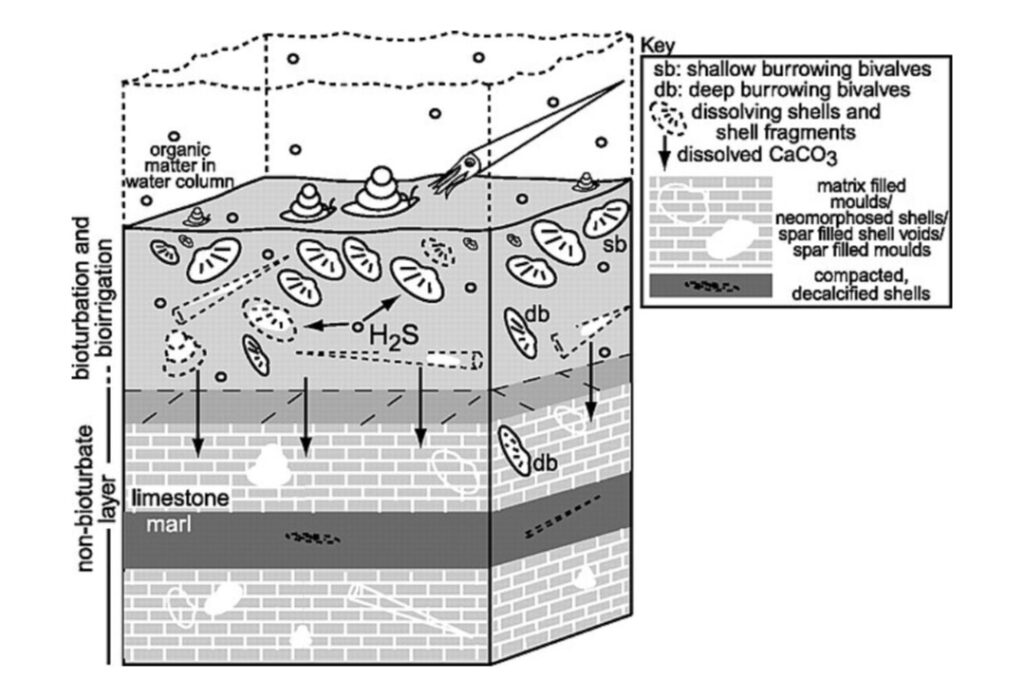
As bioturbation involves the mechanical disturbance of sediment by benthic organisms which results in the mixing of sediment particles and porewater, it also alter the structure of sedimentary deposits.
Bioturbation can be caused by the roots of large trees or by burrowing animals.
Bioirrigation on the other hand is the process by which benthic organisms flush their burrows with overlying water. This process exchanges dissolved substances between the porewater and overlying seawater, and is important in ocean biogeochemistry.
The magnitude of bioirrigation depends on the abundance of the organisms, their pumping behavior, and the environmental conditions. For example, the lugworm is a bottom dweller that produces significant bioirrigation.
Bioirrigation works as two different processes. These processes are known as particle reworking and ventilation, which is the work of benthic macro-invertebrates (usually ones that burrow). This particle reworking and ventilation is caused by the organisms when they feed (faunal feeding), defecate, burrow, and respire.
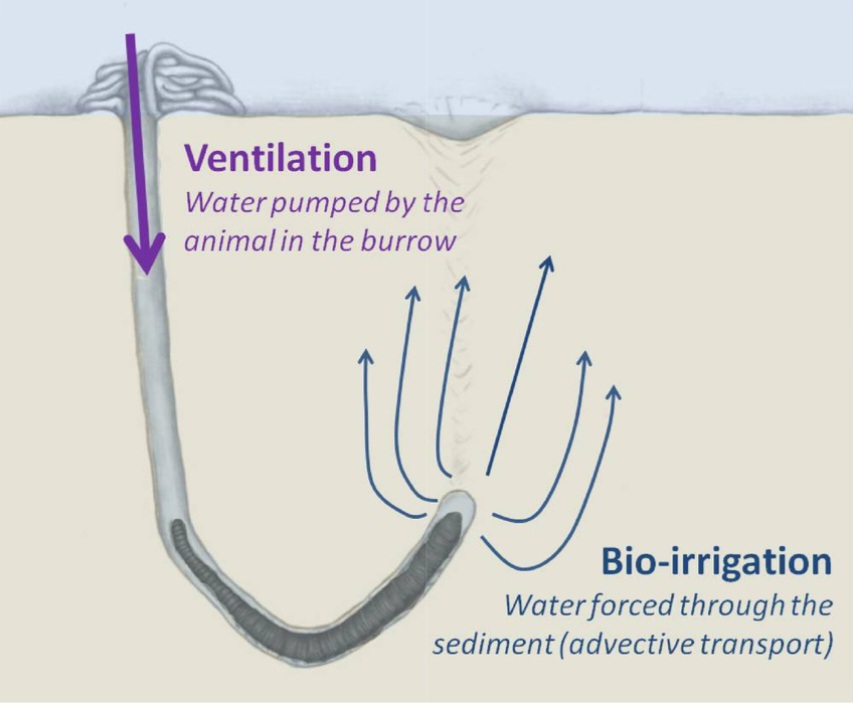
EFFECTS OF BIOTURBATION AND BIOIRRIGATION
a. PHOSPHORUS: Bioturbation can increase the flux of phosphorus into the water column, while bioirrigation can reduce this flux.
b. WATER QUALITY: Bioturbation can increase water turbidity, which can limit light penetration and inhibit the growth of macrophytes.
c. HEAVY METALS: Bioturbation and bioirrigation can promote the release of dissolved heavy metals from sediment.
d. RELEASING NUTRIENTS INTO THE WATER COLUMN: Bioturbation can release nutrients from the sediment into the water column. Bioirrigation on the other hand through the activities of infaunal organisms can introduce oxygen into burrows and surrounding anoxic sediment and at the same time enhancing the transport of nutrient-and metalrich pore-water solutes into the overlying water across a range of different sediment types.
e. REWORKING PARTICLES:
Bioturbation can rework particles and transport pore-water. Animals and plants involved in the process move sediment particles around through activities like feeding, burrowing, and defecation. While bioirrigation rework particles by activities of the benthic macro-invertebrates (usually ones that burrow) especially when water flushes through the burrows. This particle reworking are caused by the organisms when they feed (faunal feeding), defecate, burrow, and respire.
